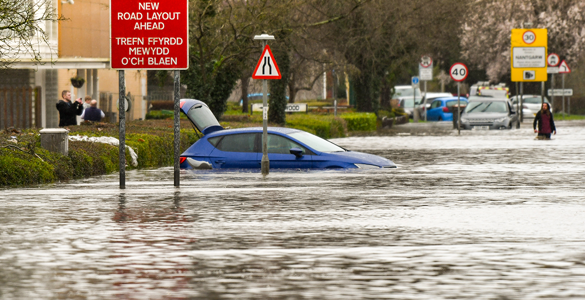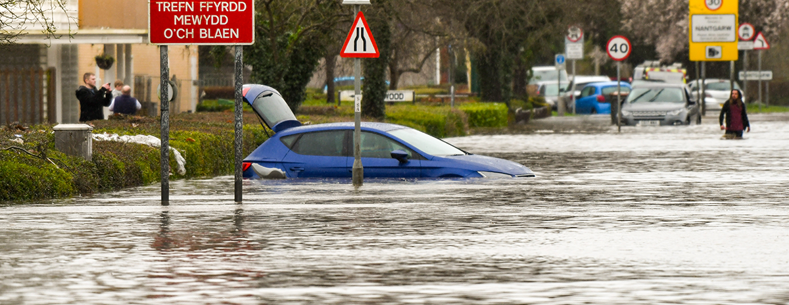On 9 February Storm Ciara caused flooding across north Wales, particularly affecting Llanrwst in the Conwy valley. Winds reached 93mph at Aberdaron on the Llŷn Peninsula, and several sites in Snowdonia saw 50-75% of their monthly rain in 18 hours.
The following weekend – 15 and 16 February – Storm Dennis hit the UK. The most affected areas were south Wales and the west midlands in England. At the peak of the storm there were 61 Flood Alerts, 89 Flood Warnings and two Severe Flood Warnings in force across Wales. On the morning of 16 February, the River Taff reached its highest levels in 40 years at Pontypridd. The River Wye at Monmouth was 70cm higher than the previous record.
What was the damage?
The Minister for Environment, Energy, and Rural Affairs, Lesley Griffiths, confirmed on 25 February that more than 1,000 homes and 300 businesses across Wales had been directly impacted by the flooding.
The storms affected infrastructure across the whole country. The A470 was closed at several locations in Gwynedd and Conwy following Storm Ciara. The rail line between Machynlleth and Shrewsbury was shut, and the line between Llandudno Junction and Blaenau Ffestiniog remains closed. The A479 at Talgarth, Powys, is also closed due to a landslide.
In Rhondda Cynon Taf (RCT), the County Borough Council (CBC) has inspected over 190 bridges, nine of which are closed. Crickhowell in Powys was inundated after the River Usk burst its banks, with around 60 homes and businesses directly affected in the town.
Llanwonno coal tip, at Tylorstown in the Rhondda valley, saw a landslide and is now under 24-hour monitoring. RCT CBC has commissioned independent assessments of its high risk coal tips. These are due to be completed by the end of the week.
A range of estimates for the cost of the damage have been put forward. Chris Bryant, MP for Rhondda, said that:
“A quarter of all the families who were affected across the whole of the United Kingdom were in one local authority in Wales, Rhondda Cynon Taff […] We have a massive bill for the local authority of more than £30 million just to put the culverts right, to dredge the rivers and to sort out the bridges that have fallen into the rivers.”
Adam Price AM suggested that the figure could be £180m in RCT alone. The First Minister, Mark Drakeford AM, responded by saying this was “not an unreasonable estimate”, but stressed that:
“It isn't possible […] to put a precise figure on how much that will be, because some of the damage that will need to be repaired is literally still under water”.
What has been the response so far?
The Welsh Government has made £10m available to help meet the costs of the initial response. Every household affected will be able to claim £500, with an additional £500 available for those without flooding insurance. The Welsh Government will provide local authorities and Natural Resources Wales (NRW) with 100% of the funding required to repair damaged defences and culverts.
RCT CBC has allocated over £2m to help with the immediate flood recovery and the renovation of damaged property. Caerphilly CBC has also allocated £250,000 to support properties affected by flooding in its area.
The First Minister assured local authorities that:
“… councils are able to use their discretionary powers to suspend council tax and non-domestic rate obligations on properties that have been flooded, and that the Welsh Government will reimburse those costs to local authorities under the emergency financial assistance scheme.”
The UK Government activated its emergency financial assistance (Bellwin) scheme on 17 February. It allows local authorities to claim 100% of their costs above a threshold from the UK Government. This scheme is only available to local authorities in England.
The Secretary of State for Environment, Food and Rural Affairs, George Eustice, was asked why funds were not available to communities in Wales. His response was that:
“flooding and response to floods is a devolved matter […] but I am aware that he [Chris Bryant] and others have raised some concerns about funding, and of course if the Welsh Government were to approach my colleagues in the Wales Office that is something that could be considered.”
On 24 February, the Minister for Finance and Trefnydd, Rebecca Evans, wrote to the UK Treasury. She confirmed that the Welsh Government would be seeking financial support for the flood recovery costs. In a letter sent to the Chair of the Assembly’s Finance Committee on 26 February, the Minister stated that the costs associated with the flood damage will be significant.
The Prime Minister, Boris Johnson, stated on 26 February that funding from the UK Government would be “passported through” to Wales.
The Secretary of State for Wales, Simon Hart, met with the First Minister and representatives of NRW, the Coal Authority and the Welsh Local Government Association to discuss the safety of coal tips. On 25 February they announced that, “information will be provided to people living in the south Wales valleys about the safety of local tips, coordinated by a single point of contact.” The meeting will reconvene next week.
Eleven Welsh MPs wrote a letter to the Secretary of State for Wales on 26 February asking the UK Government to carry out a full review of all former coal sites across the South Wales Coalfield. They also asked for a commitment to provide all funding necessary to make the sites safe.
Who is responsible for managing flood risk?
The Welsh Government is responsible for developing and applying a flood and coastal erosion risk management strategy. Local authorities, NRW, highways authorities and water and sewerage companies are also responsible for implementing the strategy.
The current national strategy was published in 2011. The Welsh Government consultation on the new strategy ended in September 2019 and the Minister has said that the final version will be published later in 2020.
The responsibility for managing coal tips lies with the tip owner (which could be a private land owner/manager, the Coal Authority, or a local authority). However, local authorities (as the enforcing authority for all disused tips) must determine if the tip poses a danger to the public and they have powers to carry out inspections and works where necessary. The Coal Authority currently inspects a large number of disused tip and quarry sites for some local authorities and statutory bodies.
What else is being done?
Crowdfunding campaigns set up by local politicians have so far raised over £70,000. In a separate campaign, actor Michael Sheen has raised nearly £60,000 for those affected by the flooding.
The Green Man Trust and Festival have pledged £10,000 towards Welsh communities and a “Valleys Aid” concert is being planned for 13-14 March in Porth, RCT. It is being supported by high-profile musicians James Dean Bradfield and Amy Wadge, with all profits going to those affected by the flooding.
With Storm Jorge forecast to hit the UK this weekend, there could be further flooding and damage. The Met Office has issued yellow weather warnings for wind and rain across Wales and at the time of writing NRW has ten flood warnings and 37 flood alerts in place.
Article by Thomas Mitcham, Senedd Research, National Assembly for Wales.
Senedd Research acknowledges the parliamentary fellowship provided to Thomas Mitcham by the Natural Environment Research Council which enabled this article to be completed.






